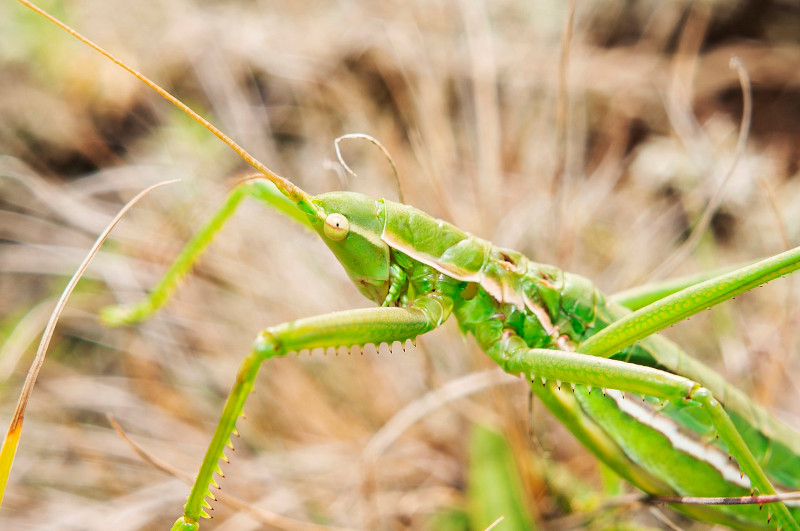
Spiked Magician Facts
- The attention-grabbing term of Spiked Magician serves as the most frequently used common name for this intriguing insect. The creature does have at least one other general title that it’s known by, though. That’s the somewhat surprising appellation of Predatory Bush Cricket.
- Inside of scientific circles, though, it’s perhaps much better known by its entirely formal moniker. Thankfully, that’s a much easier designation for the average layperson to pronounce than most. That’s because the invertebrate holds the short formal epithet of Saga pedo.
- It received that simple label due to the efforts of Peter Simon Pallas. The highly respected Prussian zoologist accomplished the first formal acknowledgement of it as a separate and distinct species. He managed that scientifically noteworthy deed back in the year 1771.
- Sadly, the population base of the Spiked Magician appears to be dwindling. That unfortunate situation additionally seems to hold true throughout the entirety of its range. The IUCN therefore presently lists the creature as Vulnerable on its Red List of Threatened Species.
- It now faces multiple threats to its continued existence as a species. Like many forms of life today, most of these stem from the actions of mankind. Its perils include habitat loss and the dangers of pesticide use. It must also now deal with the ongoing effects of climate change.
Related Articles
Spiked Magician Physical Description
The Spiked Magician immediately captures the full attention of those individuals fortunate enough to encounter it in the wild. Yet it does so for several reasons. It has a noteworthy appearance, to be sure. But it’s likely best known for the sheer physical size that individuals of the species reach.
Unlike many types of insects on earth, though, this wonder actually displays no noticeable degree of the physiological characteristic of sexual dimorphism. Distinguishing the genders with only a casual observation thus frequently challenges all but the most experienced observers of the species.
Specimens of both sexes of the species usually attain an impressive overall length that measures approximately 4.1 in (10.5 cm). That alone makes it one of the longest members of its Order on earth. Yet exceptional examples sometimes occur, reaching lengths of 4.7 in (12 cm).
These measurements include the ovipositor, though, of course. The head and body length itself typically measures a mean stretch of 2.0 – 2.8 in (5 – 7 cm). Those highly exceptional individuals mentioned previously, meanwhile, sometimes reach 3.1 in (7.8 cm) in this specific regard.
In coloring, the marvelous Spiked Magician generally presents various combinations of different shades of brown and green. This mixture of shades usually presents as slightly darker on the upper side of the body, and lighter on the under side. These amazing creatures also possess no wings.
- Kingdom: Animalia
- Phylum: Arthropoda
- Class: Insecta
- Order: Orthoptera
- Family: Tettigoniidae
- Genus: Saga
- Species: S. pedo
Spiked Magician Distribution, Habitat, and Ecology
The amazing Spiked Magician evolved as native to a considerable expanse of the surface of the globe. The full extent and nature of that zone of habitation might surprise some people, though. That’s true since it developed as endemic to roughly half of Europe and west and central Asia.
In Europe, it appears as far south as northern Greece, Italy, and the Iberian Peninsula. Northerly, it shows up as far away as both Ukraine and Slovakia. To the west, it also lives in such countries as Switzerland and France. The intrepid insect does not, however, live north of the Alpine region.
Meanwhile, in Asia, the remarkable invertebrate additionally makes its home as far south as southern sections of several countries. These locations include Armenia, Anatolia, Azerbaijan, and Turkmenistan, among others. Yet it also ranges as far north as Kurgan Oblast, in Russia.
Fortunately, this creation of Nature displays a moderate degree of adaptability in terms of its habitat preferences. Due to this flexibility, it makes its presence known within several different, albeit related, types of ecosystems. That’s a definite evolutionary advantage over its competitiors.
The Arthropod primarily dwells within one of three types of grassland biomes. Semi-natural dry grasslands with a chalky nature comprise one. Pseudo-steppe grasslands with the presence of dry grasses is another. The last one consists of similar areas in sub-Mediterranean areas.
The stunning Spiked Magician distinguishes itself from its kindred in yet another manner. While most grasshoppers developed as herbivores, this one actually feeds carnivorously! It mainly preys on other grasshoppers, crickets, and locusts. It nevertheless consumes other fare, as well.
These other victims of its voracious appetite include various types of similarly sized insects. Incredibly, these sometimes even include the usually deadly mantises, such as the European Mantis. On occasion, this extraordinary Orthoptera sometimes even consumes very small lizards.
Though technically active throughout the day, it’s principally so during the period of, and around, dusk. Its this time of the day that usually represents its preferred hunting time. Its own natural predators understandably include many birds, frogs, toads, larger lizards, and rodents.
Species Sharing Its Range
Check out our other articles on 3 Amazing North American Amphibians, Striped Skunk, Great Barrier Reef, Red Rock Crab, Orange Jewelweed, West Indian Ocean Coelacanth, Mangrove Monitor
